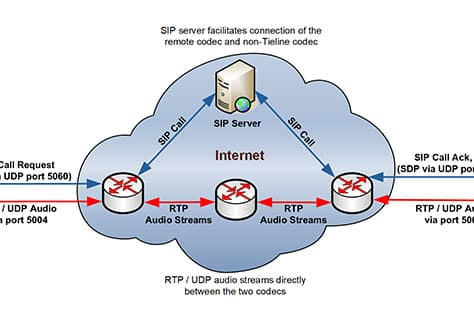In the early 2000s, codec manufacturers including Tieline, Orban/CRL, Mayah Communications and AETA Audio Systems formed a working group, and with the EBU, developed EBU-approved standards for audio contribution and broadcasting over IP.
It was during these discussions that EBU N/ACIP Tech 3326 standards were formalized to develop connectivity standards for IP streaming using Session Initiation Protocol (SIP) between different brands of audio codecs.
Since that time, a myriad of hardware and software devices for IP streaming have been developed, and these standards still form the basis of connectivity and interoperability between different broadcast codec brands.
Making SIP Calls
EBU N/ACIP Tech 3326 provides a minimum set of requirements necessary to ensure interoperability between broadcast and non-broadcast equipment for transport of audio over IP networks. It employs Session Description Protocol (SDP) and standardizes the use of ports, encoding, transport protocols and signaling, to ensure codecs and other devices like smartphones and VoIP phones can connect successfully.
Calls can be made peer-to-peer, which generally requires direct dialing of a device’s IP address. Calls can also be made via a SIP server. Using a SIP server has some advantages:
- A device can be “discovered” via its SIP server registration.
- If codecs are being used in multiple locations with DHCP-assigned IP addresses, then two devices registered to a SIP server can connect by simply dialing a SIP address.
Advantages of SIP
SIP provides interoperability between different brands of codecs due to its standardized protocols for connecting different devices using SDP. This delivers a lot of flexibility when interconnecting between different broadcast networks.
Telcos also use the SIP protocol. SIP trunking is the process of creating VoIP calls that traverse a PBX over the internet to a destination device. This device could be a hardware broadcast codec or one of the many SIP software solutions available these days. This means broadcast codecs can integrate with devices like Cisco’s Unified Call Manager (CUCM), allowing inbound VoIP callers to be integrated into the broadcast signal chain for program audio or IFB communications. This helps to bridge the Telco/broadcast network divide.
Disadvantages of SIP
To successfully make a SIP call requires two codecs to be configured with settings complying with the EBU transport layer standard, which includes mandatory encoding formats such as PCM, MPEG II, G722 and G711. However, not all codec manufacturers are fully compliant with the standard’s mandatory requirements. This can make it difficult to initiate connections or limit the encoding options available.
In addition, some ISPs or cellular networks may block SIP traffic on UDP ports 5004 (audio) and 5060 (call data) used to transport IP packets and data under the SIP standard.
Setting up a device’s SIP server registration also takes time and effort to configure. However, once registered, it is relatively simple to connect.
Perhaps the critical thing that SIP cannot provide is the support for advanced IP streaming enhancements developed over the last decade or so. This is largely driven by manufacturers designing new technology with the “secret sauce” that delivers a competitive advantage over regular SIP devices.
These include:
- IP data aggregation and bonding
- Automated IP failover
- Error concealment strategies
Proprietary IP streaming protocols can provide these features and also facilitate seamless call establishment. For example, when a Tieline IP codec dials another Tieline codec, proprietary session data automatically configures the answering codec with the preferred encoding type, connection bit-rate, redundant streaming and a range of other settings.
In summary, SIP has its place in the broadcast kitbag, as it delivers many flexible interoperability features and options that broadcasters can employ. However, it does not always provide the robust connections and redundancy required for mission-critical broadcast IP streaming applications.
The author manages technical communications for Tieline.

